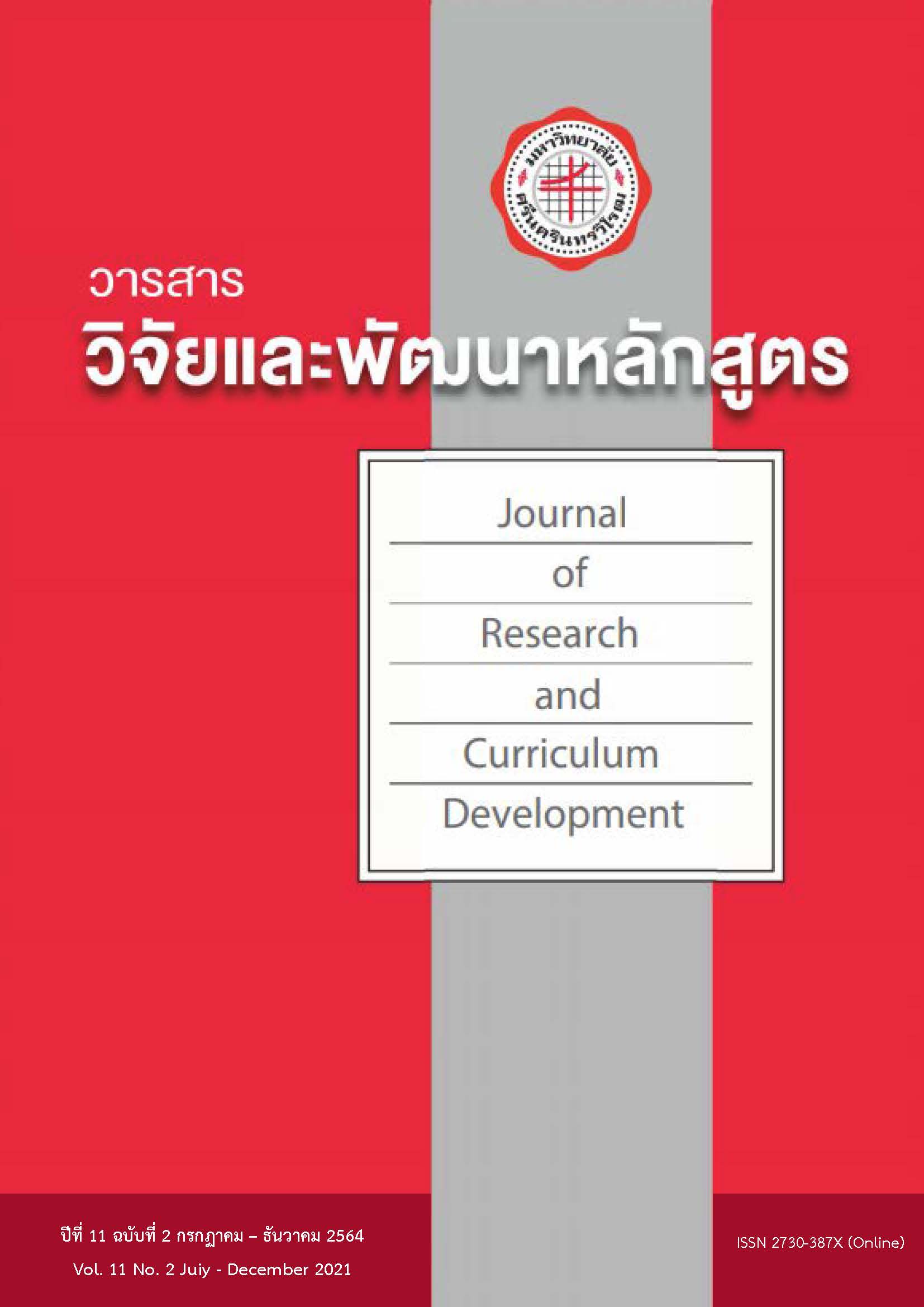การพัฒนารูปแบบการจัดการเรียนรู้วรรณคดีไทยตามแนวคิด Active Learning เพื่อส่งเสริมความสามารถ ในการแก้ปัญหาเชิงสร้างสรรค์ และความซาบซึ้งในวรรณคดีไทยของนักเรียนระดับชั้นมัธยมศึกษาตอนปลาย
Keywords:
Learning Management Model for Thai Literature, Based/Active Learning, Creative Problem Solving, Literary AppreciationAbstract
The purposes of this research were to: 1) develop and determine the efficiency of a learning management model for Thai literature based on active learning, 2) evaluate the effectiveness of a learning management model for Thai literature based on active learning, 3) disseminate a learning management model for Thai literature based on active learning. The mixed method research with embedded design was conducted. The samples consisted of 30 mattayom 6/2 (grade 12) students from Suankularb Wittayalai Thonburi School; moreover, the target population consisted of 20 mattayom 5/6 (grade 11) students from Matthayom Wat Nongkhaem school during the second semester of academic year 2020. The research instruments composed of a learning management model for Thai literature based on active learning, a manual, lesson plans, an assessment of creative problem solving, an assessment of literary appreciation, and satisfaction survey. The data was analyzed by mean, standard deviation, a dependent t-test, and content analysis.The results were as follows: 1) “ACTIVE model” was a learning management model for Thai literature based on active learning to enhance creative problem solving and literary appreciation of high school student. The principle of the model was to enhance students’ creative problem solving and literary appreciation which changed students’ role from the recipients to collaborators of building knowledge and exposing knowledge by doing. The objective was to enhance creative problem solving and literary appreciation. The model was consisted of six learning steps. Those were 1) A: Activating learners thinking process, 2) C: Considering the content with three sub-steps (Analyzing the content, Appreciating the literature, and Identifying the problems), 3) T: Trying the solutions with two sub-steps (Discussing and Finding new solutions), 4) I: Ideating best solutions, 5) V: Verifying for appreciation, and 6) E: Expanding knowledge. The model was investigated by 11 experts from the connoisseurship. The model was approved to conduct to the samples. 2) The effectiveness of the ACTIVE model indicated that 2.1) the students’ creative problem-solving ability after implementing the model were higher than before attending to the class at a .05 significance level, 2.2) after implementing the model, the students’ creative problem-solving ability were continually higher, 2.3) the students assimilated the literary appreciation after implementing the model, and 2.4) the students’ satisfaction of the model were in the level of strongly agree. 3) The results of the dissemination indicated that the students’ creative problem-solving ability after implementing the model were higher than before attending to the class at a .05 significance level. Furthermore, the students assimilated the literary appreciation; in addition, the students’ satisfaction of the model were in the level of strongly agree.
References
กุสุมา รักษมณี. (2547). วรรณสารวิจัย. กรุงเทพฯ: แม่คำผาง.
กุสุมา รักษมณี. (2556). การวิจัยวรรณคดี (พิมพ์ครั้งที่ 2). กรุงเทพฯ: ภาควิชาภาษาตะวันออก คณะโบราณคดี มหาวิทยาลัย
ศิลปากร.
จินตวีร์ คล้ายสังข์. (2560). การผลิตและใช้สื่ออย่างเป็นระบบเพื่อการเรียนรู้ในศตวรรษที่ 21. กรุงเทพฯ: โรงพิมพ์แห่งจุฬาลงกรณ์
มหาวิทยาลัย.
จิรภา อรรถพร. (2557). การพัฒนารูปแบบการสอนเชิงรุกออนไลน์เพื่อส่งเสริมพฤติกรรมการเรียนรู้ของนิสิตปริญญาบัณฑิต
(วิทยานิพนธ์ครุศาสตรมหาบัณฑิต). กรุงเทพฯ: จุฬาลงกรณ์มหาวิทยาลัย.
จุฑามาศ วงษ์ยะรา. (2561, 2 พฤษภาคม). ครูผู้สอนวิชาภาษาไทย โรงเรียนมัธยมวัดสิงห์. [บทสัมภาษณ์].
ชลธิชา หอมฟุ้ง. (2557). การพัฒนารูปแบบการสอนวรรณคดีไทยโดยประยุกต์ใช้อริยสัจสี่เพื่อส่งเสริมความสามารถด้านการอ่าน
อย่างมีวิจารณญาณและแก้ไขปัญหาเชิงสร้างสรรค์ของนักศึกษาระดับปริญญาตรี (วิทยานิพนธ์ปริญญาศึกษาศาสตร
ดุษฎีบัณฑิต). นครปฐม: มหาวิทยาลัยศิลปากร.
ณัฐกร จำปาทอง. (2560, 12 ตุลาคม). ผู้อำนวยการโรงพยาบาลจิตเวชขอนแก่นราชนครินทร์. [บทสัมภาษณ์].
ทิศนา แขมมณี. (2560). ศาสตร์การสอน: องค์ความรู้เพื่อการจัดกระบวนการเรียนรู้ที่มีประสิทธิภาพ (พิมพ์ครั้งที่ 21).
กรุงเทพฯ: สํานักพิมพ์แห่งจุฬาลงกรณ์มหาวิทยาลัย.
นารินทร์ วงษ์เวก. (2561, 2 พฤษภาคม). ครูผู้สอนวิชาภาษาไทย โรงเรียนมัธยมวัดสิงห์. [บทสัมภาษณ์].
นิศารัตน์ แสงรี. (2561, 2 พฤษภาคม). ครูผู้สอนวิชาภาษาไทย โรงเรียนมัธยมวัดสิงห์. [บทสัมภาษณ์].
บริสุทธ์ธรรม พิมพ์ศิริ. ( 2559). การพัฒนารูปแบบการจัดการเรียนรู้ตามแนวคิด Constructivism เพื่อส่งเสริมความสามารถทาง
คณิตศาสตร์ของนักเรียนชั้นประถมศึกษา (วิทยานิพนธ์ปริญญาดุษฎีบัณฑิต). นครปฐม: มหาวิทยาลัยศิลปากร.
ปพนวัจน์ ลภัสภิญโญโชค. (2558). การพัฒนารูปแบบการสอนเพื่อส่งเสริมมโนทัศน์และกระบวนการทางคณิตศาสตร์สำหรับ
นักเรียนระดับประถมศึกษา (วิทยานิพนธ์ปริญญาดุษฎีบัณฑิต) นครปฐม: มหาวิทยาลัยศิลปากร.
เปรม สวนสมุทร. (2558). รสวตี: วรรณวิถีแห่งการซาบซึ้งจากวรรณคดีก้นครัว. กรุงเทพฯ: สันติศิริการพิมพ์.
ผุสดี พูลสุขกล่ำ. (2561, 2 พฤษภาคม). ครูผู้สอนวิชาภาษาไทย โรงเรียนมัธยมวัดสิงห์. [บทสัมภาษณ์].
มาเรียม นิลพันธุ์. (2558). วิธีวิจัยทางการศึกษา (พิมพ์ครั้งที่ 9). นครปฐม: ศูนย์วิจัยและพัฒนาทางการศึกษาคณะศึกษาศาสตร์
มหาวิทยาลัยศิลปากร.
รื่นฤทัย สัจจพันธุ์. (2544). วรรณคดีศึกษา. กรุงเทพฯ: ธารปัญญา.
รื่นฤทัย สัจจพันธุ์. (2549). สุนทรียภาพแห่งชีวิต. กรุงเทพฯ: ณ เพชร สำนักพิมพ์ บริษัท เฌ.เดียมอง จำกัด.
โรงเรียนสวนกุหลาบวิทยาลัย ธนบุรี. (2561). หลักสูตรสถานศึกษาโรงเรียนสวนกุหลาบวิทยาลัย ธนบุรี. กรุงเทพฯ: กลุ่ม
บริหารงานวิชาการ โรงเรียนสวนกุหลาบวิทยาลัย ธนบุรี.
วิจารณ์ พานิช. (2555). วิถีสร้างการเรียนรู้เพื่อศิษย์ในศตวรรษที่ 21. กรุงเทพฯ: มูลนิธิสดศรี-สฤษดิ์วงศ์.
“ยุทธศาสตร์ชาติ พ.ศ. 2561-2580.” (2561). ราชกิจจานุเบกษา เล่ม 135, ตอนที่ 82 ก (13 ตุลาคม) : 1.
ยูเนสโก. (2540). รายงานเสนอต่อยูเนสโกโดยคณะกรรมาธิการนานาชาติว่าด้วยการศึกษาในศตวรรษที่ 21. กรุงเทพฯ : สำนักงาน
คณะกรรมการการศึกษาแห่งชาติ.
วรรณภา ทรงเสรีย์. (2561, 2 พฤษภาคม). ครูผู้สอนวิชาภาษาไทย โรงเรียนมัธยมวัดสิงห์. [บทสัมภาษณ์].
วัชรา เล่าเรียนดี. (2552). รูปแบบและกลยุทธ์การจัดการเรียนรู้เพื่อพัฒนาทักษะการคิด (พิมพ์ครั้งที่ 5). นครปฐม: มหาวิทยาลัย
ศิลปากร.
วัชรา เล่าเรียนดี. (2556). ศาสตร์การนิเทศการสอน และการโค้ช การพัฒนาวิชาชีพ : ทฤษฎีกลยุทธ์สู่การปฏิบัติ (พิมพ์ครั้งที่ 12).
นครปฐม: โรงพิมพ์มหาวิทยาลัยศิลปากร วิทยาเขตพระราชวังสนามจันทร์ นครปฐม.
ศิวกานท์ ปทุมสูติ. (2561, 23 ตุลาคม). นักเขียน. [บทสัมภาษณ์].
สถาพร พฤฑฒิกุล. (2555). คุณภาพผู้เรียน...เกิดจำกกระบวนการเรียนรู้ (QUALITY OF STUDENTS DERIVED FROM ACTIVE
LEARNING PROCESS. วารสารการบริหารการศึกษา มหาวิทยาลัยบูรพา, 6(2), 1-13.
สร้อยสน สกลรักษ์. (2541). แนวการสอนวรรณคดีมรดกในระดับมัธยมศึกษา. วารสารครุศาสตร์, 26(2), 39-49.
สุกาญจนา คุปต์ตระกูล. (2561, 2 พฤษภาคม). ครูผู้สอนวิชาภาษาไทย โรงเรียนมัธยมวัดสิงห์. [บทสัมภาษณ์].
สุภัทรา ภูษิตรัตนาวลี. (2560). การพัฒนารูปแบบการจัดการเรียนรู้เชิงรุกสำหรับคณาจารย์วิทยาลัย เทคโนโลยีภาคใต้ (ปริญญา
นิพนธ์ดุษฎีบัณฑิต). กรุงเทพฯ: มหาวิทยาลัยศรีนครินทรวิโรฒ.
อลงกต ปัญญาจันทร์. (2551). การส่งเสริมความเข้าใจในการอ่านภาษาอังกฤษ ความซาบซึ้งในวรรณคดีและความสามารถในการ
อภิปรายเป็นภาษาอังกฤษ โดยใช้กิจกรรมแวดวงวรรณกรรม (วิทยานิพนธ์ปริญญามหาบัณฑิต). เชียงใหม่:
มหาวิทยาลัยเชียงใหม่.
อัจจิมา เกิดผล. (2539). ภาษาไทยเพื่อการสื่อสารอย่างมีประสิทธิภาพ. กรุงเทพฯ: คณะครุศาสตร์ จุฬาลงกรณ์มหาวิทยาลัย.
อารีย์ คลิ้งเคล้า. (2561, 2 พฤษภาคม). ครูผู้สอนวิชาภาษาไทย โรงเรียนมัธยมวัดสิงห์. [บทสัมภาษณ์].
อิงอร สุพันธุวณิช และคณะ. (2554). ชุดฝึกอบรมครูภาษาไทย ระดับมัธยมศึกษาตอนปลายโครงการยกระดับคุณภาพครูทั้งระบบ
ตามแผนปฏิบัติการไทยเข้มแข็ง. กรุงเทพฯ: โรงพิมพ์แห่งจุฬาลงกรณ์มหาวิทยาลัย.
Bonwell, C.C. . (1991). Active Learning : Creating Excitement in the Classroom. Washington D.C.: ERIC
Claeringhouse on Higher Education.
Casakin, H., David, N., & Milgram, R. M. (2010). Creative Thinking as a Predictor of Creative Problem Solving in
Architectural Design Students. American Psychological Association, 4(1), 31 –35.
David L . Goetsch and Stanley B. Davis. (1997). A review of: “Quality management (Third edition). Prentice Hall.
Encyclopedia. (2008, 17 October). Creative Problem Solving. Accessed. Retrieved from
http://www.en.wikipedia.org/wiki/creative_problem_solving.
Felder, R. M. & Brent, R. (2009). Active learning: An introduction. ASQ Higher Education Brief, 2(1), 4-9.
Joyce, B., Weil, M., Calhoun, E. (2009). Models of teaching. (8th ed.). Boston, MA: Pearson Education, Inc.
Isaksen, S.G., & Treffinger, D.J. (2004). Celebrating 50 years of reflective practice:Versions of creative problem
solving. Journal of Creative Behavior, 38(2), 75-101.
McKinsey. (2010, 12 June). How the world’s most improved school systems keep getting better.
Retrieved from http://mckinseyonsociety.com/how-the-worlds-most-improved-school-systems-keepgetting-better/
Osborn, A. (1963). Applied imagination: Principles and procedures of creative thinking (3rd ed.). New York, NY:
Charles Scribner’s Sons.





